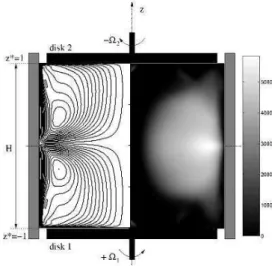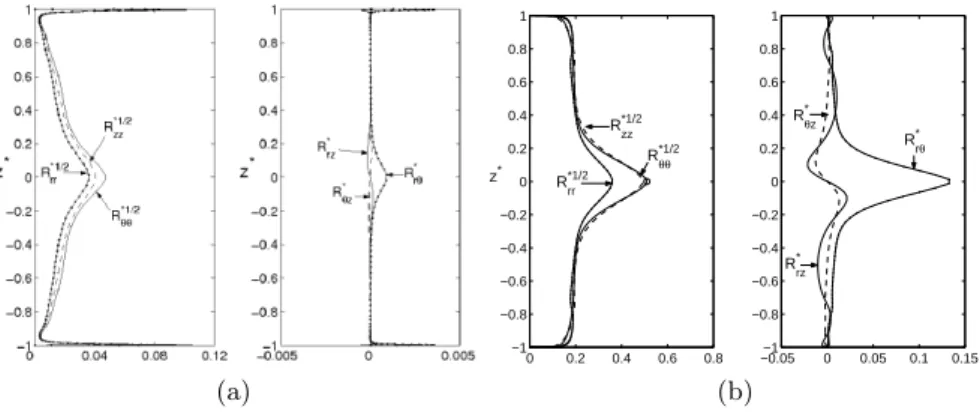HAL Id: hal-00170257
https://hal.archives-ouvertes.fr/hal-00170257
Submitted on 7 Sep 2007
HAL is a multi-disciplinary open access
archive for the deposit and dissemination of
sci-entific research documents, whether they are
pub-lished or not. The documents may come from
teaching and research institutions in France or
abroad, or from public or private research centers.
L’archive ouverte pluridisciplinaire HAL, est
destinée au dépôt et à la diffusion de documents
scientifiques de niveau recherche, publiés ou non,
émanant des établissements d’enseignement et de
recherche français ou étrangers, des laboratoires
publics ou privés.
Turbulent Von Karman Swirling Flows
Sébastien Poncet, Roland Schiestel, Romain Monchaux
To cite this version:
Sébastien Poncet, Roland Schiestel, Romain Monchaux. Turbulent Von Karman Swirling Flows.
11th EUROMECH European Turbulence Conference, Jun 2007, Porto, Portugal. pp.547-549.
�hal-00170257�
Turbulent Von K´
arm´
an Swirling Flows
S. Poncet1, R. Schiestel2
, and R. Monchaux3 1
MSNM-GP, UMR 6181, Technopˆole Chˆateau-Gombert, 38 rue F. Joliot-Curie, 13541 Marseille - France poncet@l3m.univ-mrs.fr
2
IRPHE, UMR 6594, Technopˆole Chˆateau-Gombert, 49 rue F. Joliot-Curie, 13384 Marseille - France schiestel@irphe.univ-mrs.fr
3
Service de Physique de l’Etat Condens´e / GIT, CEA Saclay, 91191 Gif sur Yvette - France romain.monchaux@cea.fr
We investigate the turbulent Von K´arm´an flow generated by two counter-rotating flat or bladed disks. Numerical predictions based on a Reynolds Stress Model (RSM) are compared to velocity measurements performed at CEA [2]. This flow is of practical importance in many industrial devices such as in gas-turbine aeroengines. From an academic point of view, this configuration is often used for studying fundamental aspects of developed turbulence and especially of magneto-hydrodynamic turbulence.
1 Geometrical model and numerical approach
The Von K´arm´an geometry is composed of two counter-rotating disks (R = 92.5 mm) enclosed by a stationary cylinder (Rc = 100 mm) (Fig.1). The
in-terdisk spacing H can vary in the range 10 − 180 mm. We use bladed disks (n blades of height h) to ensure inertial stirring or flat disks for viscous stirring. The rotation rates Ω1, Ω2 can be increased up to 900 rpm. The main flow
is controlled by three parameters: the ratio between the two rotation rates Γ = −Ω2/Ω1, the aspect ratio of the cavity G = H/Rc and the Reynolds
number Re = Ω1R 2
c/ν. In the following, G = 1.8 and Γ = −1.
Our numerical approach is based on one-point statistical modeling using a low Reynolds number second-order full stress transport closure (Reynolds Stress Model, RSM) sensitized to rotation effects and already validated for Γ = 0 and a wide range of G and Re [1]. To model straight blade effects, we add a volumic drag force in the equation of Vθ the tangential velocity
compo-nent: f = nρCD(Ω1,2r − Vθ)|Ω1,2r − Vθ|/(4πr), where ρ is the fluid density,
CD= 0.5 the drag coefficient and r the local radius. The procedure is based
on a finite volume method using staggered grids for mean velocity components with axisymmetry hypothesis. A 1202
(resp. 1602
) mesh in the (r, z) frame is used in the smooth (resp. bladed) disk case. About 20000 iterations (several
2 S. Poncet, R. Schiestel, and R. Monchaux
hours on the bi-Opteron 18 nodes cluster of IRPHE) are necessary to obtain the numerical convergence of the calculation.
2 Results
The mean flow is decomposed into two poloidal cells (fig.1) in the (r,z) plane. In the viscous stirring case, the flow structure is of Batchelor type close to the periphery of the cavity at r/Rc = 0.81 (fig.2a) and so exhibits five distinct
zones: two thin boundary layers on each disk, a shear layer at mid-plane and two cores on either side of this layer. For an inertially driven flow, the mean flow is divided into three main regions (fig.2b): a very intense shear layer at mid-plane and two fluid regions close to each bladed disks. At the top of the blades, there is a strong decrease of |Vθ| interpreted as the wake of the blades.
The turbulence is mainly confined in the equatorial plane (fig.3a,1) and is found to be almost isotropic in that region for viscous stirring. When one imposes inertial stirring, the normal components are increased by a factor 10 (fig.2b) and a much higher shear stress is obtained around z∗= 0. The weak
discrepancies between the two approaches are attributed to the appearance of strong coherent structures observed in the experiments [2].
Fig. 1. Sketch of the cavity in the smooth disk case. Computed (left) streamlines and (right) iso-turbulence Reynolds number Ret= k
2
/(νǫ) for Re = 6.28 × 105
.
3 Conclusion
We proposed an easy and efficient way to model the effects of impellers on the turbulent Von K´arm´an flow. A parametric study according to the flow
Turbulent Von K´arm´an Swirling Flows 3
(a) (b)
Fig. 2. Axial profiles of Vθ/(Ω1r): (a) viscous stirring (Re = 6.28 × 10 5
, r/Rc =
0.81), (b) inertial stirring (Re = 2 × 105
, n = 8, h/Rc = 0.2, r/Rc = 0.4). (lines) RSM, (◦) LDV data of [2]. 0 0.2 0.4 0.6 0.8 −1 −0.8 −0.6 −0.4 −0.2 0 0.2 0.4 0.6 0.8 1 z* −0.05−1 0 0.05 0.1 0.15 −0.8 −0.6 −0.4 −0.2 0 0.2 0.4 0.6 0.8 1 R θθ *1/2 R zz *1/2 Rrr*1/2 R rz * R rθ * R θz * (a) (b)
Fig. 3. Axial profiles of the Reynolds stress tensor at r/Rc = 0.81: (a) viscous
stirring (Re = 6.28 × 105
), (b) inertial stirring (Re = 2 × 105
, n = 8, h/Rc= 0.2)
(RSM). (◦) LDV data of Ravelet [2] for R∗1/2 θθ .
control parameters has been performed for viscous and inertial stirrings. In particular, we highlighted three main transitions: Batchelor / Stewartson, Batchelor / torsional Couette, one-cell / two-cell regimes. Some calculations for curved blades are still in progress.
References
1. S. Poncet, M.P. Chauve, R. Schiestel: Phys. Fluids 17(7), 075110 (2005) 2. F. Ravelet: Bifurcations globales hydrodynamiques et magntohydrodynamiques
dans un ´ecoulement de Von K´arm´an turbulent. PhD Thesis, ´Ecole Polytech-nique, Palaiseau (2005)

